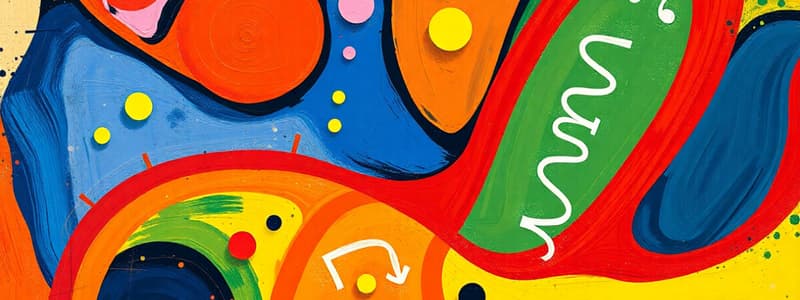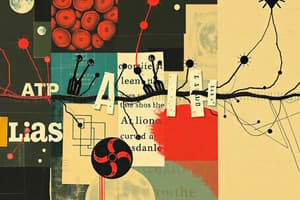Podcast
Questions and Answers
What is the role of catabolic reactions?
What is the role of catabolic reactions?
They break down larger molecules into smaller molecules and release energy.
What molecule is used to transfer energy from catabolic to anabolic reactions?
What molecule is used to transfer energy from catabolic to anabolic reactions?
ATP
What is the yield of ATP hydrolysis to ADP and inorganic phosphate?
What is the yield of ATP hydrolysis to ADP and inorganic phosphate?
- 10.2 kcal/mol
- 7.3 kcal/mol (correct)
- 4.3 kcal/mol
- 2.8 kcal/mol
Anabolic reactions require energy.
Anabolic reactions require energy.
What happens to NAD+ when it accepts electrons?
What happens to NAD+ when it accepts electrons?
What is intermediary metabolism?
What is intermediary metabolism?
What is produced during glycolysis from one glucose molecule?
What is produced during glycolysis from one glucose molecule?
Match the following enzymes with their functions:
Match the following enzymes with their functions:
Under anaerobic conditions, NADH can be reused in glycolysis.
Under anaerobic conditions, NADH can be reused in glycolysis.
Fermentation converts pyruvate into another molecule, regenerating ______.
Fermentation converts pyruvate into another molecule, regenerating ______.
Where do the remaining reactions of cellular respiration take place?
Where do the remaining reactions of cellular respiration take place?
What is the function of the mitochondrial matrix?
What is the function of the mitochondrial matrix?
What is formed when acetyl CoA enters the Krebs cycle?
What is formed when acetyl CoA enters the Krebs cycle?
Flashcards are hidden until you start studying
Study Notes
Catabolism and Anabolism
- Catabolic reactions break down larger molecules into smaller molecules and release energy.
- Anabolic reactions build larger molecules from smaller molecules and require energy.
- Some energy from catabolic reactions fuels anabolic reactions.
- ATP is the molecule that transfers energy between catabolic and anabolic reactions.
- ATP hydrolysis to ADP and inorganic phosphate releases 7.3 kcal/mol.
- ATP often transfers a high energy phosphate group to reactant molecules, altering an endergonic reaction to become exergonic.
- Cells gather energy by extracting high energy electrons from molecules, using electron carriers like NAD+.
- NAD+ becomes reduced by accepting high energy electrons.
- NAD+ becomes oxidized by donating high energy electrons.
Intermediary Metabolism
- Intermediary metabolism is the cellular process of breaking down glucose to release energy and produce ATP.
- It consists of glycolysis, the transition reaction, the Krebs cycle, the electron transport chain, and ATP synthase.
- Energy is released from glucose slowly in order to capture more energy.
Glycolysis
- Glycolysis is the first step of intermediary metabolism and occurs in the cytoplasm.
- Glycolysis is common in nearly all living organisms and can function with or without oxygen.
- Glycolysis has a preparatory phase where ATP is used to energize the glucose molecule.
- The preparatory phase ends with the splitting of glucose into two three-carbon molecules, glyceraldehyde-3-phosphate and dihydroxyacetone phosphate.
- Glyceraldehyde-3-phosphate enters the energy payoff phase.
- The energy payoff phase includes reactions that produce ATP (through substrate-level phosphorylation) and NADH.
- For each glucose molecule, glycolysis produces 2 ATP, 2 NADH and 2 pyruvate.
- ATP is produced through substrate-level phosphorylation, a process catalyzed by kinases.
- NADH is produced through reactions catalyzed by dehydrogenases.
- Other sugars can be metabolized through glycolysis by being converted to glucose or entering later in the pathway.
- The NADH generated in glycolysis will be used to donate high-energy electrons to the electron transport chain.
- In the absence of oxygen, the electron transport chain shuts down, resulting in a build-up of NADH with no way to release its electrons.
- This build-up halts glycolysis, as the reaction which produces NADH stops due to the lack of available NAD+.
Fermentation
- To keep glycolysis running in the absence of oxygen, cells undergo fermentation.
- Fermentation converts pyruvate into another molecule, regenerating NAD+ to continue glycolysis.
- Lactic acid or ethanol and carbon dioxide are the most common products of fermentation.
- Other organisms use different fermentation pathways to produce different products.
Mitochondria
- The remaining reactions of intermediary metabolism take place in the mitochondria.
- Mitochondria are membrane-bound organelles with a smooth outer membrane and convoluted inner membrane.
- The area within the inner membrane is the mitochondrial matrix, while the area between the two membranes is the intermembrane space.
- The transition reaction and Krebs cycle occur in the mitochondrial matrix, while the electron transport chain and ATP synthase are located in the inner membrane.
- Mitochondria contain their own DNA and ribosomes.
- Mitochondria likely evolved through endosymbiosis, when a large anaerobic eukaryotic cell engulfed a smaller aerobic prokaryotic cell, forming a symbiotic relationship.
- Mitochondrial DNA is small and primarily contains genes for mitochondrial ribosomal RNA and proteins.
- Most mitochondrial proteins are made from the nuclear genome and transported into the mitochondria.
- Mitochondrial DNA is highly conserved and can be used for tracing lineage due to its highly conserved nature.
The Transition Reaction
- The transition reaction is a mitochondrial process in which pyruvate produced during glycolysis is transported into the mitochondrial matrix.
- Pyruvate loses a carbon dioxide molecule, leaving an acetyl group that is attached to coenzyme A (acetyl CoA).
- The electrons released in this reaction are used to produce NADH.
- Acetyl CoA delivers the acetyl group to the Krebs cycle.
The Krebs Cycle
- The Krebs cycle (or citric acid cycle) takes place in the mitochondrial matrix.
- The Krebs cycle takes the acetyl group left over from pyruvate and attaches it to oxaloacetate, forming citrate.
- Citrate undergoes a series of isomerization reactions, followed by the release of carbon dioxide and the production of NADH.
- The product of this reaction is attached to CoA and another NADH is produced.
- The next reaction removes CoA and the released energy is used to produce ATP via substrate level phosphorylation.
- Subsequent reactions produce FADH2, produce NADH, and regenerate oxaloacetate.
- For each molecule of glucose, the Krebs cycle generates six NADH, two FADH2 and two ATP.
Studying That Suits You
Use AI to generate personalized quizzes and flashcards to suit your learning preferences.




